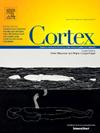全脑数字和字母解码:来自多变量功能磁共振成像分析和概率荟萃分析的聚合证据
IF 3.2
2区 心理学
Q1 BEHAVIORAL SCIENCES
引用次数: 0
摘要
先前对数字和字母的类别敏感表征的研究主要集中在单个大脑区域。本研究通过使用Elastic Net (ND-EN)进行计算严格的全脑神经解码,扩展了这一研究,促进了对整个大脑神经模式的更精确分析。为了建立我们的结果的稳健性和普遍性,我们还对现有的功能性神经影像学文献进行了创新性的概率荟萃分析。调查包括主动任务,要求参与者区分数字和字母,以及被动任务,他们只是看到这些符号。ND-EN显示,在主动任务中,一个分布式网络——包括腹侧颞枕皮质、顶叶内沟、额叶中回和脑岛——积极地区分数字和字母。这种差异在被动任务中并不明显,表明任务参与水平在这种神经分化中起着至关重要的作用。此外,腹侧颞枕皮质区域神经表征相似性分析显示,数字和字母的激活模式相似,表明先前与这些视觉符号相关的区域缺乏分化。因此,我们的研究结果表明,数字和字母的类别敏感表征并不局限于孤立的区域,而是涉及更广泛的大脑区域网络,并受到任务需求的调节。为了支持这些实证发现,使用NeuroLang和Neurosynth数据库进行的概率荟萃分析强化了我们的观察结果。综上所述,多元神经模式分析和荟萃分析的证据融合促进了我们对人类大脑中数字和字母的表达方式的理解。本文章由计算机程序翻译,如有差异,请以英文原文为准。
Brain-wide decoding of numbers and letters: Converging evidence from multivariate fMRI analysis and probabilistic meta-analysis
Previous studies exploring category-sensitive representations of numbers and letters have predominantly focused on individual brain regions. This study expands upon this research through computationally rigorous whole-brain neural decoding using Elastic Net (ND-EN), facilitating the analysis of neural patterns across the entire brain with greater precision. To establish the robustness and generalizability of our results, we also conducted innovative probabilistic meta-analyses of the extant functional neuroimaging literature. The investigation comprised both an active task, requiring participants to distinguish between numbers and letters, and a passive task where they simply viewed these symbols. ND-EN revealed that, during the active task, a distributed network—including the ventral temporal-occipital cortex, intraparietal sulcus, middle frontal gyrus, and insula—actively differentiated between numbers and letters. This distinction was not evident in the passive task, indicating that the task engagement level plays a crucial role in such neural differentiation. Further, regional neural representational similarity analyses within the ventral temporal-occipital cortex revealed similar activation patterns for numbers and letters, indicating a lack of differentiation in regions previously linked to these visual symbols. Thus, our findings indicate that category-sensitive representations of numbers and letters are not confined to isolated regions but involve a broader network of brain areas, and are modulated by task demands. Supporting these empirical findings, probabilistic meta-analyses conducted with NeuroLang and the Neurosynth database reinforced our observations. Together, the convergence of evidence from multivariate neural pattern analysis and meta-analysis advances our understanding of how numbers and letters are represented in the human brain.
求助全文
通过发布文献求助,成功后即可免费获取论文全文。
去求助
来源期刊

Cortex
医学-行为科学
CiteScore
7.00
自引率
5.60%
发文量
250
审稿时长
74 days
期刊介绍:
CORTEX is an international journal devoted to the study of cognition and of the relationship between the nervous system and mental processes, particularly as these are reflected in the behaviour of patients with acquired brain lesions, normal volunteers, children with typical and atypical development, and in the activation of brain regions and systems as recorded by functional neuroimaging techniques. It was founded in 1964 by Ennio De Renzi.
 求助内容:
求助内容: 应助结果提醒方式:
应助结果提醒方式:


